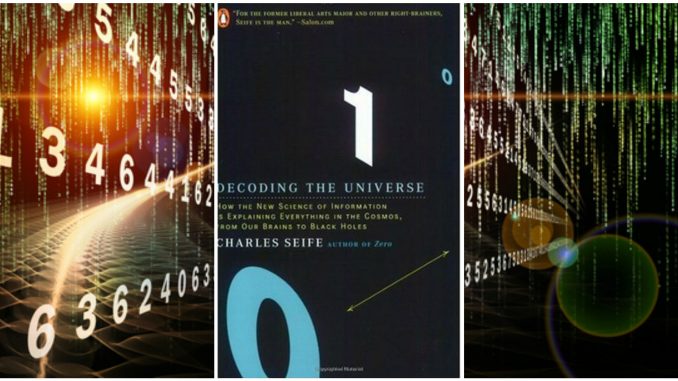
This book is a great way to have your mind well and truly blown….” – Salon.com
“Seife makes a clear case that information runs deep, akin to logic and pure mathematics, and the laws that constrain the possibilities of our world.” – New Scientist
Theoretical physicist, John Wheeler, averred that the most fundamental aspect of the Universe and, indeed, reality, is not matter or energy. It is information. If we wish to grapple with the deep laws of the cosmos and wrestle with the ultimate revelations of quantum physics we’ve got to acknowledge the supremacy of information. Decoding the Universe by Charles Seife takes the reader on a profound and intellectually invigorating ride to the cutting edge of Information Theory.
The first lesson we learn from the book is that information is more than just a description of our universe and the matter and energy in it: it is the most basic currency of existence; occupying what theorist Paul Davies terms the “ontological basement” of reality. Electrons, protons, neutrinos, quarks, bosons, and mesons are all manifestations of information. One may imagine a universe with no matter and no energy – but a universe without information is simply inconceivable. Whether, it’s in a barcode, or a computer programme, or the inside of a black hole, information is everywhere and everything.
In this book, Seife concentrates on the information theory, and discusses various issues related to it, such as decoherence and probability, relativity and quantum mechanics, the works of Turing and Schrödinger, entropy, quantum computing, superposition, and much more. For many, the word information conjures up ideas of computers and software programmes. However, information theory governs more than just how computers work. It tells us how atoms interact with each other, how black holes behave, how the universe will end. It has applications in many other areas, including statistical inference, natural language processing, cryptography, neurobiology, the evolution and function of molecular codes, model selection in ecology, thermal physics, quantum computing, linguistics, plagiarism detection, pattern recognition, anomaly detection and much more.
In fact, Seife proclaims Information Theory as the third greatest theory of the 20th century – after the Theory of Relativity and Quantum Theory. He is at pains to make the point that something seemingly abstract as information is actually measureable and palpable – because information, he says, is physical. It is a concrete property of matter and energy that can be quantified and measured.
Seife makes a fascinating study of entropy – which is a measure of information – and through a series of case studies explains its relation to the laws of thermodynamics. Perhaps his most intriguing chapter is the one titled “Life” in which he elaborates on how information is responsible for all life on earth. Every cell in our bodies is packed with information. In fact, he says, we eat so that we can process that information. Our whole being is co-opted to transmit information from generation to generation. All organisms, he explains, are ultimately entropy-discarding entities. In other words, to exist at all, each living creature must increase the entropy of its environment and reverse the ever-present degradation that the second law of thermodynamics exerts upon everything. Energy flows into cells, entropy flows out, and information is preserved. Even the earth is a giant entropy dissipating body – but only as long as the sun exists. If the sun were to disappear the oceans would freeze the planet would rapidly reach a few degrees above zero.
The book ends with an expansive look at the cosmos, the implications of living in a holographic universe, the consequences of a multiverse, and an examination of the possibility that a black hole is the ultimate computer, the ultimate processor of information.
Full of fascinating stories, and replete with riveting examples and illuminating illustrations, Decoding the Universe enlightens and entertains the reader and will definitely satisfy the curious mind. When Claude Shannon first came up with the Information Theory in 1948 and realised that information could be quantified and measured, he could only dream about the profound and far-reaching consequences his theory would have on our understanding of reality and the universe we live in.